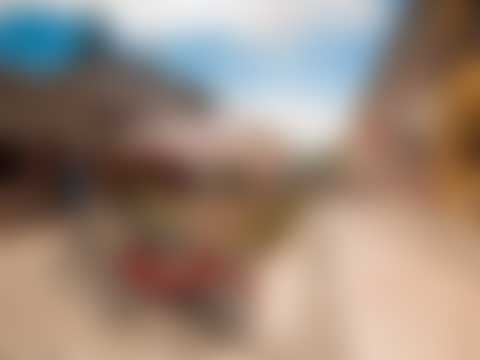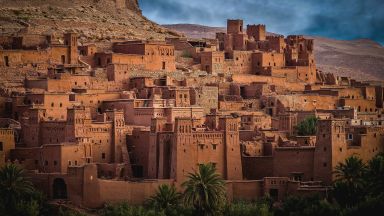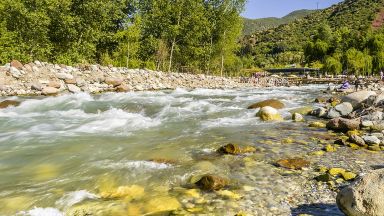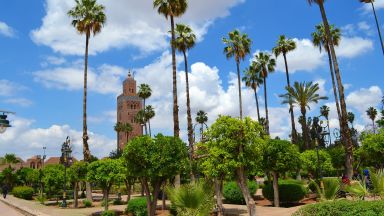Badi Palace
Palace in Marrakesh

El Badi Palace or the ‘Palace of Wonder/Brilliance’, or Badi’ Palace is a ruined palace located in Marrakesh, Morocco. It was commissioned by the sultan Ahmad al-Mansur of the Saadian dynasty a few months after his accession in 1578, with construction and embellishment continuing throughout most of his reign. The palace, decorated with materials imported from numerous countries ranging from Italy to Mali, was used for receptions and designed to showcase the Sultan’s wealth and power. It was one part of a larger Saadian palace complex occupying the Kasbah district of Marrakesh.
The palace was neglected after al-Mansur’s death in 1603 and eventually fell into ruin after the decline of the Saadian dynasty. Its valuable materials (especially marble) were stripped away and reused in other buildings across Morocco. Today it is a major tourist attraction in Marrakesh as well as an exhibition space; notably, the Minbar of the Kutubiyya Mosque is displayed here.
What does the name Badia Palace mean?
The name el-Badi’, typically translated as “the Incomparable”, is one of the 99 Names of God in Islam. Ahmad al-Mansur may have chosen the name due to his own reputed piety, but also to reflect his intention to create a superlative palace to impress guests.The name also had historical precedents in Moorish palace architecture as it was used to designate one of the pavilions in the Caliph’s palace in Cordoba, Spain (al-Andalus).
History of the Badia Palace
Background of the Badia Palace
Prior to the reign of the Saadian sultan Moulay Abdallah al-Ghalib (ruled 1557-1574), the rulers of Marrakesh resided in the old Kasbah (citadel) built by the Almohad dynasty in the late 12th and early 13th century. According to the contemporary chronicler Marmol, Moulay Abdallah, a major builder in his time, was the first to build a new palace in the area where the El Badi Palace stands, along the northern edge of the Almohad kasbah near the Kasbah Mosque and the newly-begun Saadian Tombs.The El Badi Palace proper, however, was constructed by Sultan Ahmad al-Mansur al-Dhahabi (ruled 1578-1603) at the height of the Saadian dynasty’s power. The palace’s construction, along with al-Mansur’s other projects, was probably funded by the substantial ransom paid by the Portuguese after the Battle of the Three Kings in 1578. The wealth of al-Mansur’s reign was also due to the Saadians’ control of the sugar trade. Morocco was at that time a significant exporter of sugar towards Europe, along with other products such as silk, copper, and leather. In 1590 al-Mansur launched military expeditions to the south which resulted in the conquest of Timbuktu and Gao in Mali and the defeat of the Songhai Empire. This control of the trans-Saharan trade routes allowed al-Mansur to increase Morocco’s access not only to gold but also to slaves – on which the sugar processing industry relied and which were necessary to compete with the sugar trade coming from Brazil and the Caribbean (controlled by Europeans and also reliant on slaves).
Construction of the Badia Palace
According to al-Ifrani, construction of the palace began in December 1578 (Shawwal 986 AH), only a few months after the Saadian victory at the Battle of the Three Kings and Ahmad’s accession to power, and took fifteen years, finishing in 1593 (1002 AH). French historian Gaston Deverdun, however, points out that the “Portuguese plan” of 1585 (an illustrated document providing important information on the layout of Marrakesh’s kasbah at the time) shows us a fully-completed palace, while at the same time there also exist records of Ahmad al-Mansur purchasing marble for construction up until 1602, a year before his death. This suggests that the major constructions of the palace may have been completed by the early 1580s but that al-Mansur continued to embellish the palace up until his death.
The construction of the palace was a major enterprise. The sultan had workers and artisans brought from many regions, including Europe, to aid in the construction; so much so that a flourishing market established itself near the construction site to cater to the workers.Al-Mansur was so involved in making sure that work continued efficiently that he even provided child care for his workers in order to ensure they were not distracted by other priorities.Materials were also imported from multiple regions and foreign countries, including marble columns fabricated in Italy and lime and plaster from Timbuktu.
Decline of the Badia Palace
After the fall of the Saadians and the rise of the Alaouite dynasty the palace entered a period of rapid decline. It does not appear to have been maintained after al-Mansur’s death and its premises were even plagued by malaria at one point. While the first Alaouite sultan, Moulay Rashid, was able to live here briefly in 1668-1669, less than ten years later his successor Moulay Isma’il ibn Sharif was unwilling to let ambassadors visit it because of its bad state. According to al-Ifrani, in 1707-08 (1119 AH) Moulay Isma’il ordered that the palace be demolished and stripped of its contents, materials and decorations, which were then re-used in the construction of his new palace and capital in Meknes. In reality, the dismantlement of the palace likely occurred progressively over time, beginning well before 1707 and also continuing after Moulay Isma’il. Architectural elements of Saadian origin, most likely including elements from the Badi Palace, are found in a number of buildings across Morocco and even in Algiers; for example, the Mausoleum of Moulay Isma’il in Meknes and the Zawiya of Moulay Idris II in Fes. In the meantime, the ruins of the palace became a grazing site for animals and even an owl sanctuary.
Present day
The palace today is a well-known tourist attraction. The complex contains an exhibition space where the 12th-century Almoravid minbar that once stood in the Kutubiyya Mosque is on display, in addition to other exhibition spaces opened in 2018.[6] For a number of years the Marrakesh Folklore Festival has taken place within the palace.
Architecture and layout of the Badia Palace
The Saadian palaces formed a complex built inside the vast kasbah (citadel) on the south side of the city, originally laid out during the Almohad period under Caliph Ya’qub al-Mansur. Some of the various elements of the Saadian palaces may have already been built under Abdallah al-Ghalib, while Ahmad al-Mansur added to them and embellished them. The complex was entered via a “Grand Mechouar”, a vast ceremonial square or courtyard, to the south of the Almohad-era Kasbah Mosque.The main gate of the royal palace was situated here and led to a smaller mechouar from which a long passage ran east to give access to the palace’s various components. On the south side of this passage were most of the functional annexes of the palace, including kitchens, warehouses, the treasury, and stables. On the north side of the passage was the vast reception palace, the El Badi proper, along with the private quarters of the sultan and his family, their bathhouses (hammams), a private mosque, and the mint. Finally, beyond these structures, occupying the whole eastern side of the kasbah, were a number of pleasure gardens. These included the Crystal Garden (az-zujaj), the royal garden known as al-Mustaha (“the Desired”) with a grand water basin, and the Qasr Garden or inner garden for al-Mansur’s private quarters. Ahmad al-Mansur also renovated the vast Agdal Gardens to the south of the kasbah, originally created by the Almohads. The entire palace and citadel complex was surrounded by fortified walls, as in Almohad times and as still seen today.
One curious feature inside the palace complex was a tall tower which is prominently depicted in descriptions of Marrakesh during the Saadian period but which was missing in the later Alaouite era. Of uncertain origin, this structure may have been a private observation tower dating from either the Almohad or Saadian dynasty, used for the enjoyment of the sultan and similar to smaller elevated lookouts present in some aristocratic mansions in Marrakesh and Fes.
The Badi Palace appears in our Complete Guide to Visiting Marrakesh!
This website uses affiliate links which may earn a commission at no additional cost to you!
Visiting Badi Palace
9am-5pm
adult/child Dh70/30
Nearby Attractions
- Saadian Tombs (0.3) km
Palace in Marrakesh - Bahia Palace (0.3) km
Palace in Marrakesh - Walls of Marrakesh (0.5) km
City Gate and City Walls in Marrakesh - Tiskiwin Museum (0.5) km
Museum in Marrakesh - Dar Si Said (0.6) km
Historic Building and Museum in Marrakesh - Jemaa el-Fnaa (0.9) km
Market and Square in Marrakesh - Souks of Marrakech (1.0) km
Market in Marrakesh - Kasbah Mosque (1.0) km
Mosque in Marrakesh - Koutoubia Mosque (1.0) km
Mosque in Marrakesh - Koutoubia Gardens (Lalla Hassna Park) (1.0) km
Gardens in Marrakesh


